Proper dental care is crucial for maintaining the overall health of your beloved feline friend. Just like humans, cats can experience dental issues such as dental plaque, periodontal disease, and bad breath. In this section, we will provide you with essential tips and guidance on how to ensure optimal cat dental care for your furry companion. By following these recommendations, you can help keep your cat’s teeth healthy and prevent potential dental problems.
Key Takeaways:
- Regular cat dental care is essential for keeping your cat’s teeth healthy and preventing dental diseases.
- Brushing your cat’s teeth using cat-safe toothpaste and a soft-bristle brush is an effective method to maintain good oral hygiene.
- Don’t ignore bad breath in cats, as it can be a sign of underlying dental problems.
- Annual checkups with a veterinarian are crucial for early detection and prevention of dental issues.
- Dental diets, treats, and toys can help support your cat’s dental health.
Brush Your Cat’s Teeth for Optimal Dental Care
To ensure optimal dental care for your cat, regular toothbrushing is essential. Brushing your cat’s teeth helps prevent periodontal disease, maintain fresh breath, and promote overall oral hygiene. However, it’s important to introduce toothbrushing gradually and use the proper technique for a successful brushing routine.
Introducing Toothbrushing Gradually
Most cats are not immediately comfortable with toothbrushing. It’s crucial to introduce the process slowly to avoid stress or anxiety. Start by gently touching your cat’s gums and teeth with your finger, gradually progressing to using a soft-bristle brush.
Choosing Cat-Safe Toothpaste
When brushing your cat’s teeth, it’s essential to use toothpaste formulated specifically for felines. Human toothpaste can be harmful to cats due to the presence of toxic ingredients such as fluoride. Cat-safe toothpaste comes in appealing flavors like chicken or fish to make the experience more enjoyable for your furry friend.
Proper Brushing Technique
Using a soft-bristle brush, apply a small amount of cat-safe toothpaste to the brush. Gently lift your cat’s lip to expose the teeth and gums. Brush in a circular motion, focusing on the outer surfaces of the teeth. Pay extra attention to the gum line, as plaque and bacteria tend to accumulate there. Aim for at least 30 seconds of brushing on each side of your cat’s mouth.
Remember, patience and consistency are key when it comes to brushing your cat’s teeth. Start with short sessions and gradually increase the duration as your cat becomes more comfortable with the process.
Regular toothbrushing is the most effective method for preventing periodontal disease in cats. By incorporating this routine into your cat’s dental care regimen, you can significantly improve their oral health and overall well-being.
| Toothbrush | Toothpaste | Description |
|---|---|---|
| Soft-bristle brush | Cat-safe toothpaste | Gentle brush that effectively removes plaque |
| Finger toothbrush | Cat-specific toothpaste | Allows for more precise control while brushing |
| Dental wipes | Flavored toothpaste | Convenient alternative for cats who dislike brushing |
Don’t Ignore Bad Breath in Cats
Bad breath in cats is not just unpleasant; it can also be a sign of underlying dental issues that require attention. Plaque formation and gum inflammation can lead to bad breath, indicating the presence of gingivitis or other dental problems. Ignoring bad breath in cats can lead to more severe issues such as tartar buildup and periodontal disease if left untreated.
Early detection of dental problems is crucial for maintaining your cat’s oral health. By being proactive and addressing bad breath early on, you can prevent further complications and ensure your cat’s overall well-being.
The Progression of Plaque to Tartar
Plaque is a sticky, colorless film that forms on the teeth and gum line. When it is not removed through regular dental care, such as brushing, it hardens into tartar. Tartar is a calcified deposit that firmly adheres to the tooth surface and can only be removed by a professional dental cleaning.
The Impact of Gum Inflammation on Overall Dental Health
Gum inflammation, also known as gingivitis, is an early stage of gum disease that causes red, swollen, and bleeding gums. If left untreated, it can progress to periodontal disease, a more severe condition that affects the tissues and structures supporting the teeth. Periodontal disease can lead to tooth loss and other health complications.
Regular dental care and early detection of dental problems are essential for maintaining your cat’s oral health. By recognizing the signs of bad breath and addressing it promptly, you can prevent the progression of plaque to tartar, control gum inflammation, and ensure the longevity of your cat’s teeth and gums.
| Dental Issue | Signs and Symptoms |
|---|---|
| Plaque Formation | Foul odor, visible yellowish film on teeth |
| Gingivitis | Red, swollen, and bleeding gums |
| Tartar Buildup | Hard, brown or yellow coating on teeth |
| Periodontal Disease | Loose or missing teeth, receding gum line |
Annual Checkups for Cat Dental Care
Regular annual checkups with a veterinarian are crucial for maintaining your cat’s dental health. These checkups go beyond just a physical examination and allow the vet to assess your cat’s oral hygiene and catch any dental issues early on. During the checkup, the veterinarian will look for signs of dental disease, such as gum recession, loose teeth, and missing teeth. By identifying these signs, they can recommend appropriate treatment and preventive measures to ensure your cat’s dental well-being.
One important aspect of the annual checkup is dental cleaning under anesthesia. This procedure allows the vet to thoroughly clean your cat’s teeth, removing plaque and tartar buildup that cannot be addressed with regular brushing. Dental cleaning under anesthesia ensures that your cat remains calm and comfortable during the procedure, allowing the veterinarian to perform a comprehensive cleaning without causing any stress or pain.
It is recommended to schedule your cat’s first dental cleaning under anesthesia between the ages of one to two years, depending on their overall dental health. This proactive approach sets a solid foundation for their future dental care and helps prevent the development of more severe dental issues later in life.
Understanding the Importance of Annual Wellness Exams
Annual wellness exams are a crucial part of maintaining your cat’s overall health, and dental care is a significant aspect of these exams. During these checkups, the vet will not only focus on dental health but also examine your cat’s organs, joints, and overall well-being. This comprehensive examination allows the veterinarian to identify any potential dental issues and recommend necessary treatments or interventions.
The Signs of Dental Disease to Look Out For
As a responsible cat owner, it’s essential to be aware of the signs of dental disease in cats. Some common signs to look out for include bad breath, bleeding gums, gum recession, drooling, and changes in eating behaviors. If you notice any of these signs, it’s crucial to schedule a veterinary appointment as soon as possible for a proper diagnosis and treatment plan.
To summarize, annual checkups are fundamental for maintaining your cat’s dental health. These wellness exams allow veterinarians to detect signs of dental disease, such as gum recession, loose teeth, and missing teeth. Dental cleaning under anesthesia forms an essential part of these checkups, ensuring thorough plaque and tartar removal. By prioritizing regular checkups and dental cleanings, you can provide the best dental care for your beloved feline companion.
Dental Diets for Cat Dental Care
Dental diets are a valuable tool for maintaining your cat’s dental health. These specialized diets are designed to reduce plaque and tartar buildup, promoting oral hygiene and overall well-being. They provide a toothbrush-like effect, helping to clean your cat’s teeth as they chew.
One of the key benefits of dental diets is their ability to target plaque and tartar reduction. These diets typically contain ingredients that help break down existing plaque, preventing it from hardening into tartar. By minimizing tartar buildup, dental diets contribute to healthier teeth and gums.
Furthermore, dental diets offer more than just dental benefits. They often include ingredients that support your cat’s overall health, such as antioxidants and omega-3 fatty acids. These nutrients can help boost your cat’s immune system and promote healthy skin and coat.
In addition to dental diets, there are other at-home dental care options available for your cat. Dental treats and supplements can complement the effects of dental diets, providing additional support for your cat’s oral health. However, it’s important to choose dental products that are specifically formulated for cats to ensure their safety and effectiveness.
Introducing dental diets into your cat’s daily routine can greatly contribute to their oral hygiene and overall health. Consult with your veterinarian to determine the most suitable dental diet for your cat based on their specific needs and oral health condition.
Take a closer look at the benefits of dental diets:
- Reduces plaque and tartar buildup
- Promotes oral hygiene
- Offers a toothbrush-like effect
- Supports overall health with beneficial ingredients
To provide you with a visual representation, here’s a table outlining the advantages of dental diets:
| Dental Diets Benefits |
|---|
| Reduces plaque and tartar buildup |
| Promotes oral hygiene |
| Offers a toothbrush-like effect |
| Supports overall health with beneficial ingredients |

Dental Treats for Healthy Feline Teeth
Dental treats are a valuable addition to your cat’s oral hygiene routine. These specialized treats not only offer a delicious snack but also promote dental health by reducing plaque and tartar buildup. By including dental treats in your cat’s diet, you can help maintain their healthy teeth and gums. Additionally, dental treats often come in various flavors, which can also serve as breath fresheners for your furry friend.
Dental treats work by incorporating ingredients that help reduce plaque and tartar formation. They are designed to have a textured surface that helps mechanically remove plaque while your cat enjoys their treat. The action of chewing the treat creates a gentle abrasive effect that can help prevent the accumulation of plaque and tartar, reducing the risk of dental problems down the line.
The Benefits of Dental Treats:
- Plaque and Tartar Reduction: Dental treats are formulated to target plaque and tartar buildup, helping to keep your cat’s teeth clean and healthy.
- Breath Fresheners: Some dental treats are specifically designed to combat bad breath in cats, providing a fresh and pleasant aroma.
- Enrichment and Stimulation: Chewing on dental treats can provide entertainment and mental stimulation for your cat, promoting their overall well-being.
Recommended Dental Treat Brands:
| Brand | Benefits |
|---|---|
| Brand A | Reduces plaque and tartar Freshens breath Delicious flavor options |
| Brand B | Promotes healthy gums Helps clean teeth Irresistible taste |
| Brand C | Combats bad breath Supports oral health Natural ingredients |
When choosing dental treats for your cat, opt for reputable brands that have been proven effective in reducing tartar and promoting dental health. It is recommended to consult with your veterinarian to determine the most suitable dental treat option for your cat’s specific needs and preferences.
Remember, while dental treats can be beneficial for your cat’s dental health, they should not replace regular toothbrushing or professional dental cleanings. A comprehensive oral hygiene routine, including brushing their teeth and regular veterinary check-ups, is essential for maintaining optimal dental health in your feline companion.
Dental Toys for Enriching Cat Dental Health
Toys play a crucial role in maintaining feline dental health by encouraging chewing and gnawing, which helps clean their teeth. It’s not just about playtime; dental toys can provide essential oral hygiene benefits for your furry companion.
When cats chew and gnaw on dental toys, it stimulates saliva production, which helps wash away bacteria and food particles that can lead to plaque and tartar buildup. The chewing action also helps massage the gums, promoting better blood circulation and reducing the risk of gum disease.
Choosing appropriate dental toys is essential to ensure safe play and maximum benefit. Look for toys specifically designed for dental care, such as those with ridges or bristles that can effectively clean your cat’s teeth. Avoid toys with small parts that could be easily swallowed or cause choking hazards.
Dental toys are not only beneficial for your cat’s oral health but can also provide mental and physical stimulation. They help satisfy your cat’s natural instincts to chew, preventing boredom and destructive behaviors.
Take some time to explore the variety of cat dental toys available in the market. From chew bones to interactive toys, you’ll find options that suit your cat’s preferences. Remember to supervise your cat’s playtime with dental toys to ensure their safety.
Encourage your cat to engage with dental toys regularly, making it a part of their play routine. Rotate the toys to keep your cat interested and to provide different textures and shapes for optimal dental care.
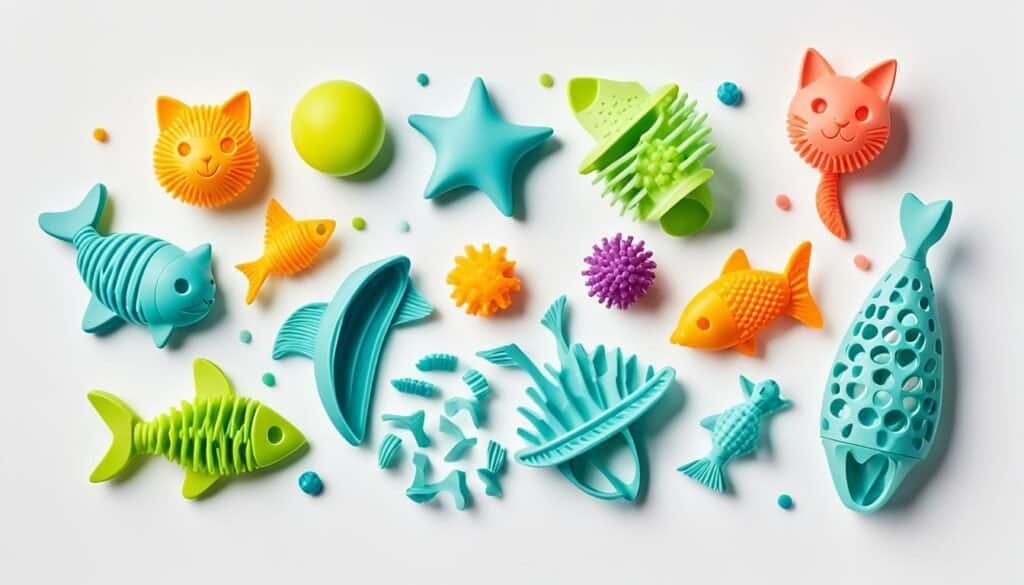
The Benefits of Dental Toys for Cats:
- Promote teeth cleaning by encouraging chewing and gnawing
- Stimulate saliva production to wash away bacteria and food particles
- Massage the gums, promoting better blood circulation and reducing the risk of gum disease
- Provide mental and physical stimulation, preventing boredom and destructive behaviors
Investing in dental toys for your cat can contribute to their overall dental health and well-being. Regular playtime with these toys will not only keep their teeth cleaner but also provide them with enjoyment and improve their quality of life.
Importance of Cat Dental Care
Proper dental care for cats is essential for their overall health and well-being. It not only helps maintain their oral health but also has a significant impact on their overall health. By prioritizing cat dental care, you can prevent gum disease, tooth loss, and the potential negative effects on other organs in their body.
Oral health plays a crucial role in a cat’s overall well-being. Just like humans, cats can develop gum disease, which can lead to tooth loss and other oral health complications. Additionally, gum disease in cats has been linked to various systemic conditions, including heart disease, kidney problems, and diabetes. Maintaining good oral health is key to preventing these health issues and promoting a long and healthy life for your feline companion.
The Importance of Gum Disease Prevention
Gum disease, also known as periodontal disease, is a common condition in cats. It occurs when there is a buildup of plaque and tartar on the teeth, leading to inflammation and infection of the gums. If left untreated, gum disease can result in tooth loss and even the spread of bacteria to other parts of the body.
Preventing gum disease through regular dental care can help avoid these complications. Brushing your cat’s teeth, providing dental treats or toys, and incorporating dental diets into their nutrition can all contribute to gum disease prevention. These preventive measures help remove plaque and tartar, reducing the risk of gum inflammation and infections.
Preventing Tooth Loss and its Impact
Tooth loss is not just an aesthetic concern for cats—it can significantly impact their quality of life. Without proper dental care, cats may develop dental issues that lead to loose or missing teeth. This can affect their ability to eat, groom themselves, and even play comfortably. Additionally, missing teeth can alter their bite and cause pain or discomfort.
By implementing regular dental care practices, you can help prevent tooth loss in cats. Brushing their teeth, providing dental treats or toys that promote chewing, and scheduling professional dental cleanings are all effective ways to maintain their oral health and prevent tooth loss.
Overall Health Impacts
The oral health of cats is closely linked to their overall health. Poor dental hygiene can contribute to the development of various systemic diseases and conditions. Bacteria from the mouth can enter the bloodstream and affect vital organs, including the heart, kidneys, and liver.
By prioritizing cat dental care, you can help reduce the risk of these health issues. Regular brushing, professional cleanings, and a balanced diet that supports oral health can have significant positive impacts on your cat’s overall well-being. Remember, investing in their dental health is investing in their overall health and happiness.
| Benefits of Cat Dental Care | Preventive Measures | Overall Cat Health |
|---|---|---|
| Prevention of gum disease | Regular brushing | Reduced risk of systemic diseases |
| Prevention of tooth loss | Dental treats and toys | Improved quality of life |
| Reduced risk of systemic diseases | Professional dental cleanings | Enhanced overall well-being |
Understanding Cat Dental Problems
Dental problems in cats can have a significant impact on their overall health and well-being. It is essential for cat owners to have a comprehensive understanding of common dental issues such as plaque, tartar, gingivitis, and periodontal disease. This section will provide valuable insights into how these problems develop and the risks associated with bacterial buildup and infections. By recognizing the importance of proactive dental care, cat owners can take necessary steps to ensure their feline companions’ dental health.
Plaque and Tartar
Plaque is a sticky film that forms on the teeth as a result of bacteria accumulation. Over time, if not adequately removed, plaque hardens and turns into tartar. Tartar buildup on the teeth can lead to various dental issues, including gum inflammation, gum recession, and even tooth loss. Furthermore, tartar provides a conducive environment for bacteria, increasing the risks of infections and other oral health complications.
Gingivitis and Periodontal Disease
Gingivitis is the inflammation of the gums caused by the presence of plaque and tartar. If left untreated, gingivitis can progress into periodontal disease, a more severe condition that affects the tissues surrounding the teeth. Periodontal disease can lead to bone loss, tooth mobility, and even systemic infections if bacteria enter the bloodstream.
Bacteria Buildup and Infection Risks
The accumulation of plaque and tartar in a cat’s mouth creates an ideal environment for bacteria to thrive. Bacteria can invade the gum tissues, leading to infections and causing pain and discomfort for the cat. In severe cases, the bacteria can enter the bloodstream and potentially affect other organs, posing significant health risks for the cat.
Understanding these dental problems is crucial for cat owners to recognize the signs and symptoms, seek early veterinary intervention, and implement preventive measures. A proactive approach to cat dental care can help maintain optimal oral health, prevent dental diseases, and contribute to the overall well-being of your furry companion.
| Dental Problem | Description | Consequences |
|---|---|---|
| Plaque | A sticky film of bacteria that forms on the teeth. | Can lead to tartar buildup, gingivitis, and periodontal disease if not addressed. |
| Tartar | Hardened plaque that accumulates on the teeth. | Can cause gum inflammation, gum recession, tooth loss, and increase infection risks. |
| Gingivitis | Inflammation of the gums caused by plaque and tartar. | If left untreated, can progress to periodontal disease and cause tooth and bone damage. |
| Periodontal Disease | A more severe condition affecting the tissues surrounding the teeth. | Can result in bone loss, tooth mobility, and systemic infections. |
Signs of Dental Problems in Cats
Recognizing the signs and symptoms of dental problems in cats is crucial for their overall health and well-being. By being aware of these indicators, cat owners can promptly seek veterinary care and address dental issues before they worsen. Here are some common signs to watch out for:
- Bad breath: If your cat has persistent bad breath, it may be a sign of dental problems such as gum disease or tooth decay. A foul odor from the mouth should not be ignored.
- Bleeding gums: Healthy gums should be pink and free from bleeding. If you notice your cat’s gums bleeding during regular activities such as eating or brushing, it could indicate gum inflammation or infection.
- Gum inflammation: Swollen, red, or inflamed gums are often a sign of periodontal disease in cats. This condition can cause discomfort and pain, leading to difficulty in eating or even loss of appetite.
- Drooling: Excessive drooling in cats can be a result of oral pain or discomfort. Drooling coupled with other signs like bad breath or changes in eating behavior should be evaluated by a veterinarian.
- Changes in eating behavior: Cats with dental problems may exhibit changes in their eating habits. They may show reluctance to eat hard food, chew on one side of the mouth, or experience weight loss due to pain or difficulty while eating.
If you observe any of these signs in your cat, it is essential to schedule a veterinary visit for a thorough examination and appropriate treatment. Early intervention can prevent further complications and ensure your cat’s dental health.
Importance of Professional Dental Cleanings
Professional dental cleanings play a crucial role in maintaining optimal dental health for cats. These cleanings provide a range of benefits that go beyond what owners can achieve through regular oral care at home.
During a professional dental cleaning, veterinarians perform a thorough examination of your cat’s mouth to identify any underlying dental issues or potential problems. This comprehensive evaluation allows for early detection and intervention, preventing more severe dental issues in the future.
One of the main objectives of a professional dental cleaning is to remove plaque and tartar buildup. Plaque is a sticky film that forms on the teeth and can eventually harden into tartar, which can lead to gum inflammation and periodontal disease if left untreated. The dental cleaning process effectively removes these harmful deposits, preserving your cat’s dental health and preventing further complications.
It is normal for owners to have concerns about the use of anesthesia during the dental cleaning procedure. However, anesthesia is essential to ensure the safety and comfort of the cat throughout the process. Veterinarians take all necessary precautions and tailor the anesthesia protocol to each individual cat, minimizing any potential risks. The use of anesthesia allows for a more thorough and effective cleaning, as it enables the veterinarian to reach all areas of the mouth without causing discomfort to the cat.
Overall, professional dental cleanings provide a level of care that goes beyond what can be achieved at home. They are an important part of preventive dental care and can significantly contribute to a cat’s overall health and well-being. Regular professional cleanings, combined with a proper oral hygiene routine at home, can help ensure that your feline companion enjoys good dental health for years to come.
Benefits of Professional Dental Cleanings:
- Thorough examination to detect dental issues
- Removal of plaque and tartar buildup
- Prevention of gum inflammation and periodontal disease
- Safe use of anesthesia for a comfortable experience
- Contribution to overall dental health and well-being
Conclusion
In conclusion, cat dental care is crucial for maintaining the overall health and well-being of your feline companion. By implementing dental hygiene practices and preventive measures such as regular brushing, veterinary check-ups, dental diets, treats, toys, and professional cleanings, you can ensure optimal cat health.
Proper dental hygiene, including brushing your cat’s teeth with a cat-safe toothpaste and a soft-bristle brush, helps prevent periodontal disease and reduces the risk of other dental problems. Regular visits to the veterinarian for annual check-ups allow for the early detection of dental issues like plaque, tartar, gum inflammation, and tooth loss, ensuring prompt treatment.
Additionally, incorporating dental diets into your cat’s regular feeding routine can help reduce plaque and tartar buildup, while dental treats serve as a delicious and effective way to promote oral health and freshen your cat’s breath. Providing appropriate dental toys can also contribute to the cleaning of your cat’s teeth through chewing and gnawing.
By prioritizing cat dental care and following these guidelines, you are taking proactive measures to maintain your cat’s dental hygiene, leading to greater overall cat health and a longer, happier life for your beloved feline friend.
FAQ
What can I do to maintain my cat’s dental health?
How do I brush my cat’s teeth?
Why is bad breath in cats important?
How often should I take my cat for dental check-ups?
How do dental diets help with cat dental care?
Are there dental treats available for cats?
How do dental toys contribute to cat dental health?
Why is cat dental care important for overall health?
What are common cat dental problems?
What are the signs of dental problems in cats?
Why are professional dental cleanings necessary for cat dental care?
What is the significance of cat dental care?
Last modified: February 19, 2024

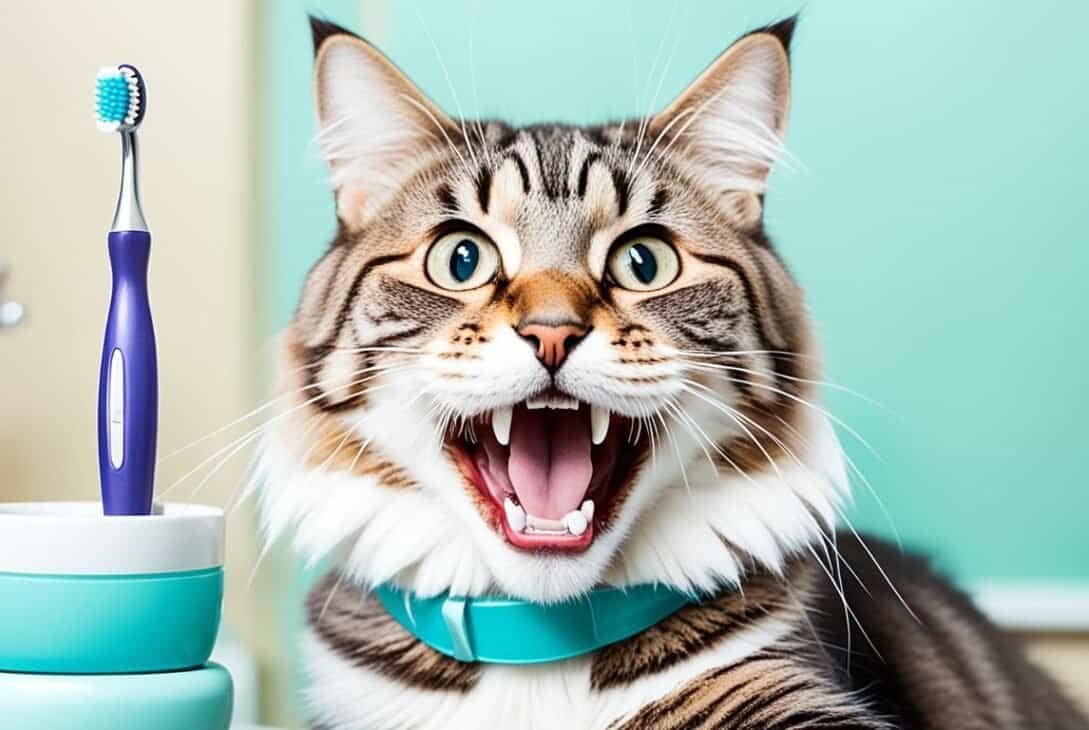
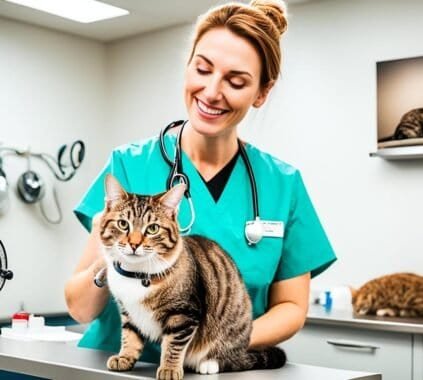
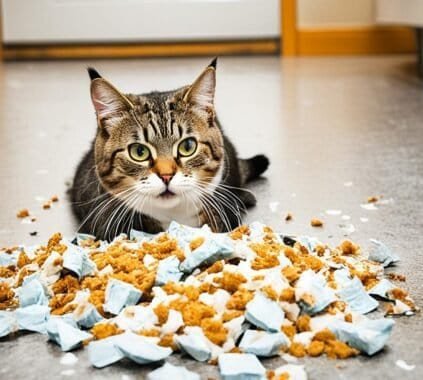
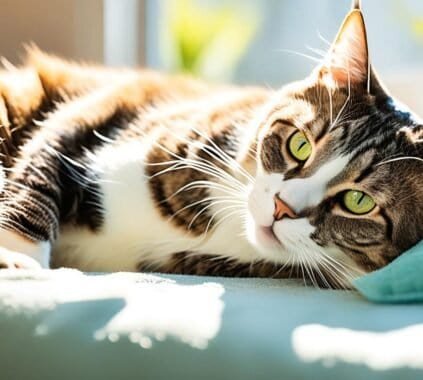
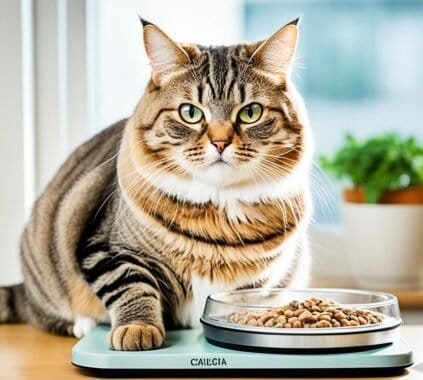








[…] Dental Health: Cats’ teeth go through specific changes as they age, providing valuable clues about their age. Kittens have 26 deciduous teeth, which are eventually replaced by 30 permanent teeth by the age of six months. As cats grow older, their teeth may show signs of wear and tartar buildup, indicating a more advanced age. […]
[…] the importance of keeping their feline companions safe and healthy. One essential aspect of cat care is preventing parasites. These tiny organisms, such as fleas and worms, can cause discomfort, […]
[…] essential for cat owners. Regular visits to the veterinarian, proper vaccination protocols, and a healthy lifestyle can help prevent and manage these feline health […]
[…] reproductive organs, ensuring that your cat cannot reproduce. Many pet owners choose to have their cats spayed or neutered at a spay-neuter clinic due to the affordability and specialized care they […]
[…] vaccinations are essential for feline health care and disease […]
[…] wellness exams play a vital role in keeping cats healthy and ensuring their well-being. During these comprehensive checkups, veterinarians conduct a series […]
[…] be familiar with. By gaining knowledge about these cat sicknesses, owners can ensure that their cats receive the proper care and prompt treatment they […]
[…] needs. Cat health and feline wellness greatly depend on proper water consumption. Here are some cat care tips to ensure your feline friend stays […]
[…] in their natural instincts as hunters and their drive to provide for their young or family members. Cats may perceive their owners as part of their close-knit family and feel compelled to share their … and provision. This prey-sharing behavior is an instinctive way for cats to show their nurturing […]